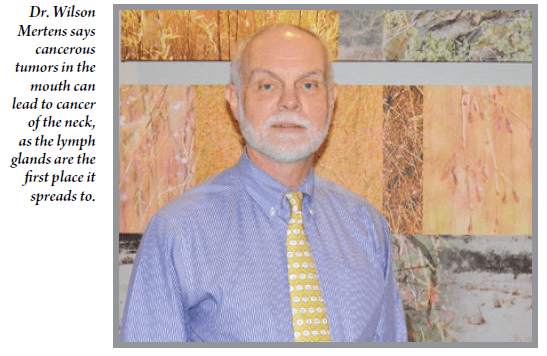Something Else to Chew On – The Dangers of Smokeless Tobacco Are Leading to Calls for Action
Professional baseball players can be seen using smokeless tobacco during televised games. But many major-league players, including Hall of Famer Tony Gwynn and Red Sox pitcher Curt Shilling, attribute the mouth cancer they were diagnosed with directly to their use of the product.
Gwynn lost his battle to the disease 14 months ago, and last month Schilling joined Boston mayor Martin Walsh in calling for a ban on smokeless tobacco in all of the city’s ballparks. Although Schilling said he believes Walsh’s proposal will meet with resistance from major-league players, he thinks they will eventually accept it.
Still, it’s a product that can be disguised, and Springfield College head baseball coach Mark Simeone says some players put a wad of it inside chewing gum while they are on the field.
“Smokeless tobacco is highly addictive, but there is a misnomer about it: People think because it’s not lit up, it’s not dangerous; but that’s a myth,” he said, adding that years ago professional athletes, including football players Earl Campbell and Walt Garrison, endorsed the product on television.
“They showed people how to put a wad between their cheek and gum for pleasure,” he said. “The ads conveyed a positive message for a dangerous product.”
Dr. Zubeena Mateen, hematologist/oncologist and medical director of Hemotology Oncology at Holyoke Medical Center, says smokeless tobacco is not only a serious health hazard, it’s three to four times more addictive than smoking.
“People think they can use it as a bridge to quit smoking, but it’s more difficult to stop using it than cigarettes because it contains more nicotine,” she explained. “However, it’s not just the nicotine that’s a problem. It contains 28 carcinogens that include small amounts of arsenic, formaldehye, nickel, cadmium, and other known poisons and can cause a host of problems. They can begin with receding gums and gum disease or gingivitis, and extends to tooth loss, cancer of the lip, mouth, roof of the mouth or neck, which can spread to the esophagus, stomach, and pancreas.

“Oral cancer is a horrible disease, and the treatments for it are tough,” she went on. “Radiation therapy can be used to try to save tongue function, but we may have to remove the tongue, which means people can’t talk, eat, or swallow. And during radiation, people are very sick. Their mouth may become so inflamed they need tube feeding.
“There is also some evidence that smokeless tobacco can cause serious heart attacks that people are more likely to die from than heart attacks caused by other health issues,” she continued. “It’s not proven, but there is a definite association.”
Dr. Wilson Mertens agrees.
“The cancers caused by smokeless tobacco are pretty unpleasant to treat,” said the medical director of cancer services for Baystate Regional Cancer Program. “Radiation affects swallowing, speech, and appearance, and surgery can be quite disfiguring; very few people return to normal.”
He went on to note that most tumors in the mouth are removed surgically, but the radiation leaves long-term side effects and people may have to have some, if not all, of their teeth removed. It also contributes heavily to tooth decay because the acidic property of the tobacco eats the enamel and roots of the teeth.
“The cancer can spread into the neck, which may require removal of the lymph glands,” he told HCN. “It’s the first area it travels to from the mouth.”
Unfortunately, education about these harmful effects has been limited, and according to the American Cancer Society (ACS), approximately 46{06cf2b9696b159f874511d23dbc893eb1ac83014175ed30550cfff22781411e5} of people try it for the first time when they are under the age of 18, and 9 million people in the U.S. use smokeless tobacco on a daily basis.
“Schilling has become an advocate for banning it, but the problem is that ball players are role models and whatever they do on the ball field, kids will imitate,” Mateen said. “They think it’s the fashionable thing to do and don’t realize how harmful it is.”
Drug of Choice
Smokeless tobacco comes in two basic forms: chewing tobacco and snuff. The ACS says chewing tobacco is made up of long strands of loose leaves, plugs, or twists of tobacco, and pieces of it, commonly called plugs, wads, or chew, are chewed or placed between the cheek and gum or teeth. The nicotine in the piece is absorbed through the mouth tissues and the user spits out the brown saliva that soaks through the product.

Snuff is finely ground tobacco packaged in cans or pouches, and can be purchased dry or moist. Moist snuff users have different names for a wad, which include a pinch, dip, lipper, or quid. It is placed between the lower lip or cheek and gum and the nicotine is absorbed through the tissues of the mouth. It can also be purchased in small, teabag-like pouches or sachets that are placed between the cheek and gum and marketed as a discreet way to use tobacco.
Dry snuff is sold in a powdered form and is used by sniffing or inhaling the powder up the nose.
A third form, called snus, was first marketed in Sweden and Norway and although it has fewer of the tobacco-specific nitrosamines known to cause cancer, that’s because Swedish snus is processed under very specific manufacturing standards that limit the toxins. But that’s not the case with American-made snus, and Swedish studies show users have a higher risk than non-users for pancreatic, stomach, mouth, and esophageal cancer.
Factors that seem to be linked to whether young people will use tobacco include examples set by parents, peer pressure, local lifestyles and fashions, general attitudes toward authority, economic conditions, examples set by teachers and school staff members, the presence of gangs in their neighborhood, and whether a youth uses drugs and alcohol.
“There is a culture around tobacco use, and smokeless tobacco users don’t view their habit in the same way as smoking cigarettes,” Mertens said. “When you smoke, most of the cigarette burns up in the atmosphere. But chewing tobacco lasts until it’s gone and is concentrated in one spot in the mouth.”
The use of snuff is more difficult to quantify, but it can lead to cancer in the nasal passages. “It’s an uncommon cancer, but the incidence is higher in people who use smokeless tobacco and we see people in their 20s and early 30s with it, which is unusual,” said Mertens. “However, there may be some genetic interplay; we believe some people may be more sensitive to it. But people who use smokeless tobacco have a significantly higher rate of developing mouth cancer than people who smoke. It’s an avoidable risk, and those who don’t get away with it pay heavily.”
He added that cancer from tobacco use takes a long time to develop, but smokeless tobacco users often ignore symptoms that indicate something is wrong inside their mouth.
“It typically takes six months from the time a person first notices something suspicious until they see a specialist, and although these cancers tend to stay localized, they can grow for years before they are detected,” Mertens noted.
He added there aren’t many things that can be done in the realm of healthcare that make as much of a difference in preventing death or deferring it than quitting the habit or never using smokeless tobacco to begin with.
Simeone ran a summer baseball camp for a dozen years at Springfield College, and had every player watch a video titled Tragic Choice: The Bob Lemming Story, which was created by the American Baseball Coaches Assoc. and the National Spit Tobacco Education Program to educate young players about the dangers of smokeless tobacco and the chemicals it contains.
He said Lemming used the product from the time he was a young teenager and it led to an aggressive form of cancer that grew into his brain.
“He had to have half of his face removed,” Simeone said, adding the images in the video are graphic, but he thinks it’s important for young players to know what’s in the products and be scared of using them. “Smokeless tobacco contains chemicals that people would never think of ingesting or putting in their mouth.”
Preventative Measures
Mateen said it’s critical to educate young people about the dangers of smokeless tobacco.
“People are just starting to realize how bad it is. Young people can start experimenting with it and become addicted within a couple of weeks, depending on their use. Plus, they are affected by peer pressure and its availability.”
Simeone concurred. “Smokeless tobacco is banned by the National Collegiate Athletic Assoc. and has been banned in minor league baseball since 1993. As more education is made available, knowledge of the dangers may lead the major leagues to consider banning it, too,” he said.
Several years ago, major league players agreed not to carry tobacco packages and tins in their back pockets when fans are in the ballpark, or use tobacco during pre-game or post-game interviews or during team functions. But members of Congress and health organizations say that until it is banned, young athletes and teens are likely to try it and become addicted.
“There’s a mixed message being sent when it’s banned at the minor league level but is allowed at the highest level of play,” Simeone said. “And if young people idolize a player from an athletic point of view who is using it, they will continue to think it’s OK.”
And as the medical evidence clearly shows, that’s certainly not the case.


